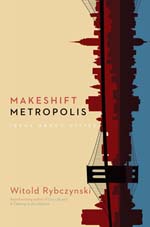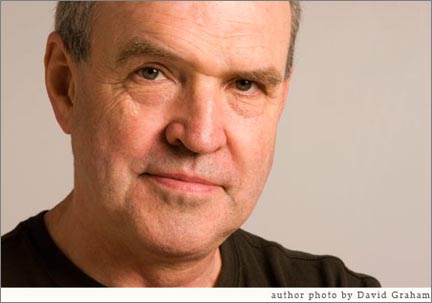In this highly readable volume, Witold Rybczynski makes a fresh argument for rethinking the field of planning. Lynn Vande Stouwe has this review of one of our selections for the Top 10 Urban Planning Books for 2011.
What do Americans want from cities?
This fundamental question, arguably unanswerable by virtue of its many answers, frames Witold Rybczynski's elegant new book, Makeshift Metropolis.
 The book marks the author's return to the big urban ideas he last addressed at length in 1996's City Life. Whereas that work was long on historical analysis and short on solutions, Makeshift Metropolis successfully bridges the divide between what has been and what can be, proposing a pragmatic approach for planners and architects to consider how cities should grow.
The book marks the author's return to the big urban ideas he last addressed at length in 1996's City Life. Whereas that work was long on historical analysis and short on solutions, Makeshift Metropolis successfully bridges the divide between what has been and what can be, proposing a pragmatic approach for planners and architects to consider how cities should grow.
Concerned primarily with the uniquely sprawling and disorderly way U.S. cities have evolved over the past four hundred years, Rybczynski begins by tracing the history of American ideas about urban form. Though American planning has been influenced by many schools of thought, some homegrown and others imported, a Rybczynski says there is a persistent disconnect between good ideas and good implementation. For example, while the archetypical colonial settlements of Williamsburg and Savannah were groundbreaking in their form, most subsequent colonial town plans lacked the nuanced details that made those places successful. As Lewis Mumford famously noted, Le Corbusier's Tower in the Park model more often resembled a "Tower in the Parking Lot" because cash-strapped cities lacked the resources to faithfully execute his vision. Even today, writes Rybczynski, creators of New Urbanist communities often take shortcuts from the original successful developments in hopes of growing profits, using cheap materials and overbuilding.
For Rybczynski, another factor remains constant throughout American planning history: urban planners, policy makers and thinkers often fail to anticipate what the true impacts of their built visions will be. He cites as a prime example large-scale urban renewal projects of the 1950's and 60's, which did little to transform struggling neighborhoods despite grand promises of revitalization. Even Jane Jacobs in her contrarian opinions missed the mark to a large extent, says Rybczynski; in most cities, newly vibrant small-scale neighborhoods attract young professionals and retirees in droves, while the suburbs continue to be the preferred location for families. More recent in planners' miscalculations is the craze for "signature buildings," with officials in every city seeking to design and construct their way to a Bilbao Effect. Ignoring lessons from the past, planners continue to chase what has worked elsewhere without questioning whether it is repeatable or desirable in their own cities.

Rybczynski argues that what planners miss in their blinders-on, top-down approach is the potential of "demand-side urbanism"-the radical idea that the public actually knows what it wants from cities and planners should listen. Planners and architects tend to think of their mission as one of re-education rather than interpretation, often trying to sell the latest trends to communities instead of accepting the realities of the urban marketplace. This tendency towards a circuitous, self-reflexive approach is intensified by the increasingly universal education that planners and architects receive, says Rybczynski, with the academic institutions that train planners parroting whatever idea is in vogue instead of encouraging critical thinking. Furthermore it has made real estate developers, who are by definition demand-driven, the true planners of our cities.
How then, can planners make themselves relevant once again? Rybczynski argues that in order to get it right, planners must lay the groundwork for organic, piecemeal growth and then, to a large extent, step away. He points to the new Israeli city of Modi'in, designed by architect Moshe Safdie, as one possibility. Modi'in follows a simple and logical development master plan that dictates major elements like the street grid and town center, but in other areas provides guidelines rather than prescriptions, permitting future market-based development. It is intended to feel like a "normal" city rather than a "planned" city, based upon parcelization along regular streets and architectural variety. Modi'in is green without relying on overly complex technologies, dense but with breathing room-in short, says Rybczynski, it is the kind of city most people probably want. All the planners had to do was listen to the market.
The difficulty in this more laissez-faire approach may be determining where to draw the line between guidance and prescription. While planners should indeed strive for relevancy, they seemingly are obligated not only to today's population but to future generations as well. Broader civic goals like making sure there is enough affordable housing to retain middle- and low-income workers and mitigating the environmental impacts from the built environment may not resolve themselves in the marketplace, but does that make them invalid? Chasing demand trends, after all, might prove just as short-sighted as chasing planning trends, as thousands of newly minted luxury condominiums now sitting empty in neighborhoods from Brooklyn to Scottsdale remind us. Perhaps the answer lies in striking a balance between the demand-side and the supply-side. Rybczynski is correct to remind planners that the process from conception to realization is not a smooth one, that it is impossible to fully ascertain effects prior to execution. A more open-ended approach to planning might indeed make for better cities if done wisely. Give and take is no doubt essential; the question is how much to give, and how much to take.
Lynn Vande Stouwe is currently interning at Planetizen while getting her Master of Urban Planning degree at New York University. Before going back to school, she was proposal manager for Ennead Architects, a New York City firm committed to building for public entities, non-profit organizations and educational institutions.

Planetizen Federal Action Tracker
A weekly monitor of how Trump’s orders and actions are impacting planners and planning in America.

Chicago’s Ghost Rails
Just beneath the surface of the modern city lie the remnants of its expansive early 20th-century streetcar system.

Amtrak Cutting Jobs, Funding to High-Speed Rail
The agency plans to cut 10 percent of its workforce and has confirmed it will not fund new high-speed rail projects.

Ohio Forces Data Centers to Prepay for Power
Utilities are calling on states to hold data center operators responsible for new energy demands to prevent leaving consumers on the hook for their bills.

MARTA CEO Steps Down Amid Citizenship Concerns
MARTA’s board announced Thursday that its chief, who is from Canada, is resigning due to questions about his immigration status.

Silicon Valley ‘Bike Superhighway’ Awarded $14M State Grant
A Caltrans grant brings the 10-mile Central Bikeway project connecting Santa Clara and East San Jose closer to fruition.
Urban Design for Planners 1: Software Tools
This six-course series explores essential urban design concepts using open source software and equips planners with the tools they need to participate fully in the urban design process.
Planning for Universal Design
Learn the tools for implementing Universal Design in planning regulations.
Caltrans
City of Fort Worth
Mpact (founded as Rail~Volution)
City of Camden Redevelopment Agency
City of Astoria
City of Portland
City of Laramie


























